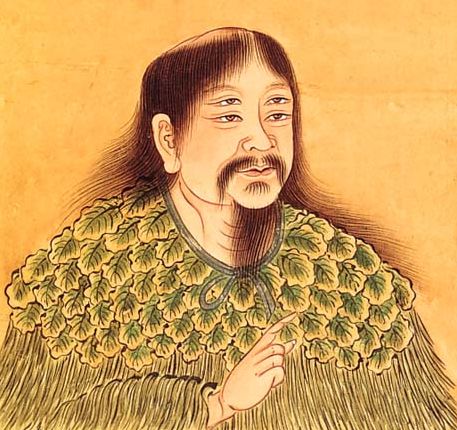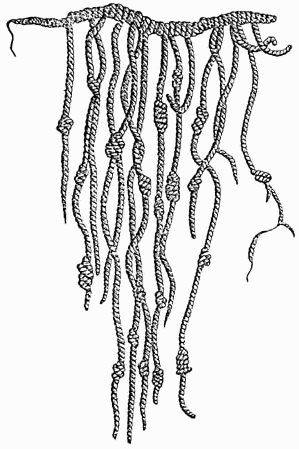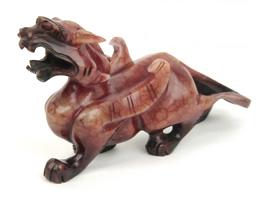Ts'ang Chieh is said to have had four eyes, and to have taken the idea of Chinese written language from the markings of birds' claws upon the sand. Upon the achievement of his task the sky rained grain and evil spirits mourned by night. Previous to this mankind had no other system than rude methods of knotting cords and notching sticks for noting events or communicating with one another at a distance.
Cangjie had four eyes and four pupils, and when he invented the characters, the deities and ghosts cried and the sky rained millet.
Shortly after unifying China, the Yellow Emperor, being dissatisfied with his "rope knot tying" method of recording information, charged Cangjie with the task of creating characters for writing.
The Yellow Emperor said, "These knots and sticks always make my head muddled. Mouse likes biting the ropes, and last night a fire almost destroyed all the sticks. Now I don't even know which prince has paid his tax, and which kingdom hasn't presented any tribute!"
Cang Jie has also been very frustrated by the knots, sometime these ropes are tangled like a broken fishing nets, the number of turns of the knots, the different colours of the cords, the size and length of ropes, and the combination of these becomes more and more complicated, which perplexes even him who has years of training and experience as a historian, not even mention the normal people. But what could be better method?
Cangjie then settled down on the bank of a river, and devoted himself to the completion of the task at hand. Even after devoting much time and effort, however, he was unable to create even one character. One day, Cangjie suddenly saw a phoenix flying in the sky above, and something dropping from its beak to the ground directly in front of Cangjie, and he saw it to be an impression of a hoof-print. Not being able to recognize which animal the print belonged to, he asked for the help of a local hunter passing by on the road. The hunter told him that this was, without a doubt, the hoof print of a Pixiu, being different from the hoof-print of any other beast alive.
"What is a Pixiu?" Cangjie asked, "I have never seen one."
"I have heard that it was a heavenly creature, resembling a winged lion. Because it had a voracious appetite for gold and silver, even stole god Shangdi's favorite golden vas, Shangdi was very so angry that he punished Pixiu by restricting his diet to gold. Thus, pixiu can only absorb gold, but cannot expel it."
"Wow, it's amazing." Cangjie said, "so you can tell any animal just by its footprint?"
"Of course, from paws and hooves to claws and talons, hairless or fury, cloven or not, big or small, number of toes, all animal feet walk upon the Earth leaves distinct footprint."
His conversation with the hunter greatly inspired Cangjie, leading him to believe that if he could capture in a drawing the special characteristics that set apart each and every thing on the earth, this would truly be the perfect kind of character for writing. From that day forward, Cangjie paid close attention to the characteristics of all things, his upper two eyes looked into the sky, identifying the sun, moon, stars, clouds; his lower two eyes looked down to the earth, differentiating mountains, lakes, trees, as well as all manner of birds and beasts. He began to create characters according to the special characteristics he found, and before long, had compiled a long list of characters for writing.
God Shangdi was watching over the Heaven, and evil spirits peeping in his dark dens on the Changjie's progress. When Shangdi and his angels found Cangjie finally completed his task, they were all applauding, He ordered to send down grains to bless the achievement of human being, but ghosts and evil spirits were all very worried, their wrongdoings now could be exposed and recorded, no hidden places would be safe for them up in the heaven and down on Earth. So they mourned for the unhappy fates.
To the delight of the Yellow Emperor, Cangjie presented him with the complete set of characters. The emperor then called the premiers of each of the nine provinces together in order for Cangjie to teach them this new writing system. Monuments and temples were erected in Cangjie's honor on the bank of the river where he created these characters.
 |
| Ts'ang Chieh had four eyes and four pupils |
 |
| knotting cords |
The Yellow Emperor said, "These knots and sticks always make my head muddled. Mouse likes biting the ropes, and last night a fire almost destroyed all the sticks. Now I don't even know which prince has paid his tax, and which kingdom hasn't presented any tribute!"
Cang Jie has also been very frustrated by the knots, sometime these ropes are tangled like a broken fishing nets, the number of turns of the knots, the different colours of the cords, the size and length of ropes, and the combination of these becomes more and more complicated, which perplexes even him who has years of training and experience as a historian, not even mention the normal people. But what could be better method?
Cangjie then settled down on the bank of a river, and devoted himself to the completion of the task at hand. Even after devoting much time and effort, however, he was unable to create even one character. One day, Cangjie suddenly saw a phoenix flying in the sky above, and something dropping from its beak to the ground directly in front of Cangjie, and he saw it to be an impression of a hoof-print. Not being able to recognize which animal the print belonged to, he asked for the help of a local hunter passing by on the road. The hunter told him that this was, without a doubt, the hoof print of a Pixiu, being different from the hoof-print of any other beast alive.
"What is a Pixiu?" Cangjie asked, "I have never seen one."
"I have heard that it was a heavenly creature, resembling a winged lion. Because it had a voracious appetite for gold and silver, even stole god Shangdi's favorite golden vas, Shangdi was very so angry that he punished Pixiu by restricting his diet to gold. Thus, pixiu can only absorb gold, but cannot expel it."
"Wow, it's amazing." Cangjie said, "so you can tell any animal just by its footprint?"
"Of course, from paws and hooves to claws and talons, hairless or fury, cloven or not, big or small, number of toes, all animal feet walk upon the Earth leaves distinct footprint."
His conversation with the hunter greatly inspired Cangjie, leading him to believe that if he could capture in a drawing the special characteristics that set apart each and every thing on the earth, this would truly be the perfect kind of character for writing. From that day forward, Cangjie paid close attention to the characteristics of all things, his upper two eyes looked into the sky, identifying the sun, moon, stars, clouds; his lower two eyes looked down to the earth, differentiating mountains, lakes, trees, as well as all manner of birds and beasts. He began to create characters according to the special characteristics he found, and before long, had compiled a long list of characters for writing.
God Shangdi was watching over the Heaven, and evil spirits peeping in his dark dens on the Changjie's progress. When Shangdi and his angels found Cangjie finally completed his task, they were all applauding, He ordered to send down grains to bless the achievement of human being, but ghosts and evil spirits were all very worried, their wrongdoings now could be exposed and recorded, no hidden places would be safe for them up in the heaven and down on Earth. So they mourned for the unhappy fates.
To the delight of the Yellow Emperor, Cangjie presented him with the complete set of characters. The emperor then called the premiers of each of the nine provinces together in order for Cangjie to teach them this new writing system. Monuments and temples were erected in Cangjie's honor on the bank of the river where he created these characters.
 |
| a Pixiu |
Comments